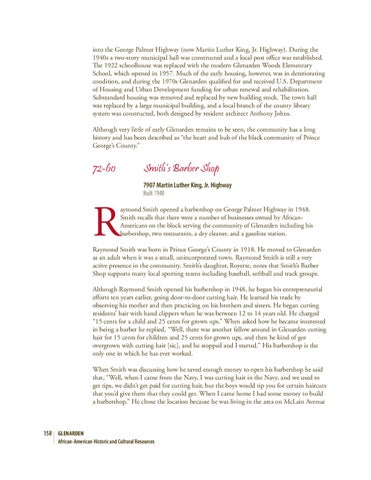into the George Palmer Highway (now Martin Luther King, Jr. Highway). During the 1940s a two-story municipal hall was constructed and a local post office was established. The 1922 schoolhouse was replaced with the modern Glenarden Woods Elementary School, which opened in 1957. Much of the early housing, however, was in deteriorating condition, and during the 1970s Glenarden qualified for and received U.S. Department of Housing and Urban Development funding for urban renewal and rehabilitation. Substandard housing was removed and replaced by new building stock. The town hall was replaced by a large municipal building, and a local branch of the county library system was constructed, both designed by resident architect Anthony Johns. Although very little of early Glenarden remains to be seen, the community has a long history and has been described as “the heart and hub of the black community of Prince George’s County.”
72-60
Smith’s Barber Shop 7907 Martin Luther King, Jr. Highway Built 1948
R
aymond Smith opened a barbershop on George Palmer Highway in 1948. Smith recalls that there were a number of businesses owned by AfricanAmericans on the block serving the community of Glenarden including his barbershop, two restaurants, a dry cleaner, and a gasoline station.
Raymond Smith was born in Prince George’s County in 1918. He moved to Glenarden as an adult when it was a small, unincorporated town. Raymond Smith is still a very active presence in the community. Smith’s daughter, Royette, notes that Smith’s Barber Shop supports many local sporting teams including baseball, softball and track groups. Although Raymond Smith opened his barbershop in 1948, he began his entrepreneurial efforts ten years earlier, going door-to-door cutting hair. He learned his trade by observing his mother and then practicing on his brothers and sisters. He began cutting residents’ hair with hand clippers when he was between 12 to 14 years old. He charged “15 cents for a child and 25 cents for grown ups.” When asked how he became interested in being a barber he replied, “Well, there was another fellow around in Glenarden cutting hair for 15 cents for children and 25 cents for grown ups, and then he kind of got overgrown with cutting hair [sic], and he stopped and I started.” His barbershop is the only one in which he has ever worked. When Smith was discussing how he saved enough money to open his barbershop he said that, “Well, when I came from the Navy, I was cutting hair in the Navy, and we used to get tips, we didn’t get paid for cutting hair, but the boys would tip you for certain haircuts that you’d give them that they could get. When I came home I had some money to build a barbershop.” He chose the location because he was living in the area on McLain Avenue
158 GLENARDEN African-American Historic and Cultural Resources
